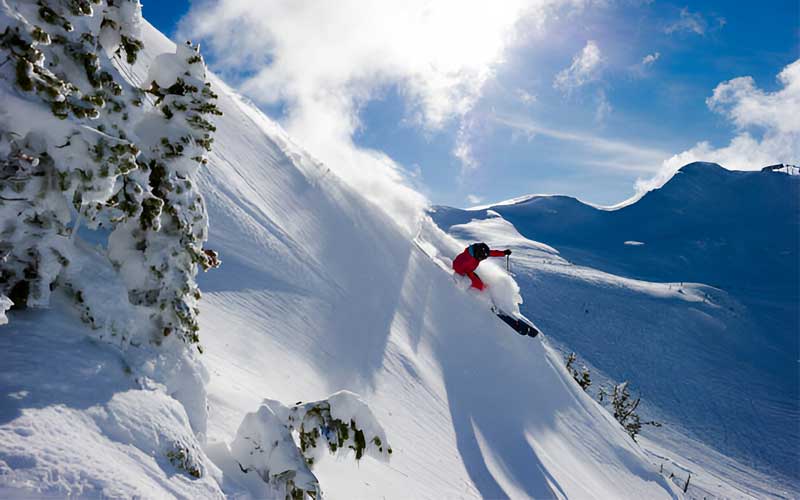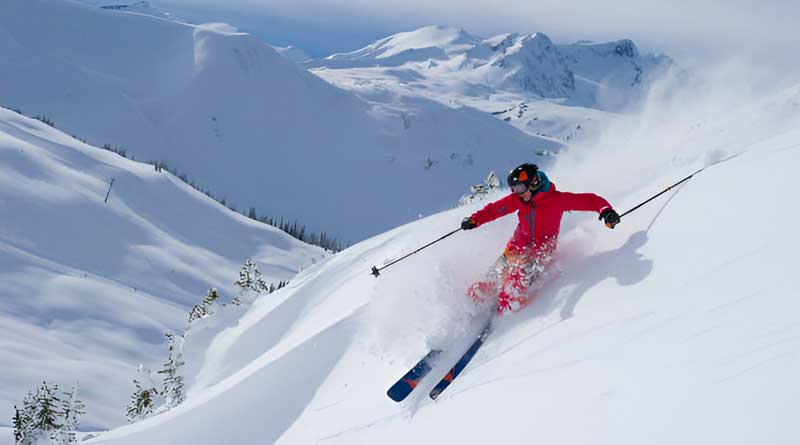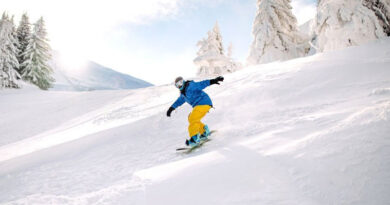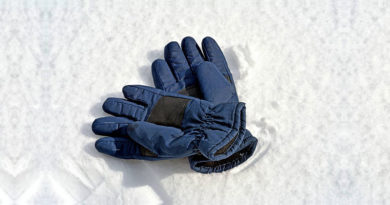Best Skis for Expert Skiers of 2025
If you’re an experienced skier, you need skis that match your skill and speed. The right skis help you stay in control. They also make tough terrain feel easier and more fun. Expert skis are made for precision, power, and quick response. They are built for steep runs, deep snow, and fast carving. In this guide, we’ve picked the best skis for expert skiers. Each one offers strong performance, top quality, and serious grip. We also cover different styles like all-mountain, powder, and backcountry. No matter your favorite terrain, you’ll find a great match here. Let’s dive into the top skis for expert-level performance.
1. Nordica Enforcer 94

-
Core: Energy 2 Ti Pulse Core (wood and elastomer between two layers of Titanal)
-
Rocker Type: All-Mountain Rocker (Rocker/Camber/Rocker)
-
Tail Type: Partial Twin Tip
-
Recommended Ability Level: Advanced–Expert
The Nordica Enforcer 94 is a top pick for aggressive skiers who want a blend of power and control. Its revamped construction features a wood and elastomer Pulse core sandwiched between two Titanal layers. This gives the ski a solid, energetic feel without becoming overly stiff. The medium turning radius helps with smooth edge-to-edge transitions, making it ideal for fast carving on groomers. The All-Mountain Rocker profile adds float and ease in variable snow while keeping strong edge hold on harder surfaces.
What makes the Enforcer 94 stand out is its ability to remain stable and damp even at high speeds, while still offering enough forgiveness to handle tight tree lines. The new tail design feels looser and more playful, so maneuvering in tighter spaces doesn’t feel like a fight. It thrives in frontside conditions but doesn’t shy away from softer snow or chopped-up terrain. Best suited for intermediate to expert skiers, this model shines for those who want a versatile ski that performs well in a mix of resort conditions.
Pros
- Excellent stability and edge hold
- Smooth and damp ride in variable conditions
- Strong carving ability on groomers
- Nimble and more playful than previous versions
Cons
- May be too stiff for true beginners
- Not ideal for deep powder days
2. Atomic Bent 110

-
Rocker Type: Powder Rocker – 25% Tip / 50% Camber / 25% Tail
-
Core: Light Woodcore – Poplar for shock absorption and stability
-
Shape: HRZN 3D Bent Tip and Tail for playfulness in freestyle terrain
-
Sidewalls: Dura Cap Sidewall – Power transmission with added durability
The Atomic Bent 110 bridges the gap between deep powder float and park-style playfulness. Light underfoot yet packed with performance, it’s a versatile all-mountain tool that’s just as happy spinning tricks off wind lips as it is charging down an open bowl. With a powder-focused rocker profile and directional shape, the Bent 110 offers great float, stability, and pop. The HRZN 3D tips and tails help keep things surfy and nimble, letting you pivot, smear, and butter with ease. Whether you’re dropping cliffs or slashing soft snow, it’s a ski that inspires creativity and flow without feeling overly demanding.
Despite its light build, the ski holds its edge well and doesn’t wash out on firmer snow. At 110mm underfoot, it hits a sweet spot for riders who want powder performance without giving up too much versatility. The construction blends poplar wood and steel edges to deliver responsiveness and control. The mid-section gives enough support to handle variable terrain, while the playful tip and tail let you experiment with style. At 188cm, it might seem long for some, but the generous rocker and low weight make it feel much shorter on snow. For skiers chasing playful pow lines and the occasional park hit, the Bent 110 is a standout.
Pros
- Extremely playful and light
- Great float in soft snow
- Stable underfoot with solid edge hold
- Versatile across park, pow, and touring
Cons
- Not ideal for icy or hardpack days
- May feel too soft for aggressive chargers
3. Salomon Depart 1.0

-
Core: Karuba / Poplar Full Woodcore with Basalt Superlight Fibers
-
Rocker Type: Freestyle Rocker – 23% Tip Rocker / Camber / 18% Tail Rocker
-
Turning Radius: Short (15m)
-
Tail Type: Full Twin Tip
The Salomon Depart 1.0 is a creative skier’s dream, designed for riders who want to break away from traditional park lines. With its freestyle rocker profile and full twin tip shape, this ski thrives when you’re hitting natural features, cruising side hits, or taking playful laps through all-mountain terrain. The Karuba and Poplar wood core gives it a solid yet energetic feel, while basalt fibers add a bit of snap without extra weight. A short 15-meter turn radius gives the Depart 1.0 a sharp, responsive edge when you want to get weird on hardpack or side trails.
This ski really shines on firm snow, holding an edge confidently even when charging hard. Thanks to the titanal binding reinforcement underfoot, the Depart 1.0 grips well without chattering. It’s stable and surprisingly damp for a freestyle ski. However, some riders may find it slightly heavier than expected, especially for a ski aimed at creative freestyle and post-park skiers. That said, its playful nature and strong performance on mixed terrain make it a fun option for advanced to expert skiers who want a bit of throwback soul with modern handling.
Pros
- Excellent edge hold on hardpack
- Stable and damp at speed
- Energetic and responsive ride
- Fun, freestyle-oriented shape for creative skiing
Cons
- Feels heavier than expected
- Not ideal for deep powder or big mountain lines
4. Blizzard Hustle 11

-
Core: TrueBlend Free Core (Beech, Poplar, Paulownia)
-
Laminates: Carbon D.R.T. (Dynamic Release Technology)
-
Rocker Type: Rocker/Camber/Rocker
-
Tail Type: Partial Twin Tip
The Blizzard Hustle 11 is a dream come true for freeride skiers who want backcountry capability without giving up downhill power. Built in the same mold as the Rustler 11, the Hustle swaps Titanal for a lighter Carbon D.R.T. insert and a weight-saving TrueBlend Free Core. This creates a ski that’s smooth, surfy, and easy to maneuver, especially in deep snow. The rocker/camber/rocker profile floats well in powder while still providing decent grip on firmer snow, making it ideal for soft snow days both in and out of bounds.
Although not as damp or stable as the Rustler 11, the Hustle 11 still handles variable terrain with confidence. It prefers smearing turns over carving and initiates easily thanks to the early rise tail and progressive shape. It’s not the lightest option for full-day tours, but it strikes a good balance for skiers who split time between the resort and sidecountry. Mount it with a hybrid touring binding, and you’ve got a versatile powder setup that’s playful, energetic, and reliable when things get deep.
Pros
- Lightweight yet stable enough for freeride descents
- Excellent float and turn initiation in soft snow
- Great hybrid ski for resort and backcountry use
- Smooth and surfy ride with playful handling
Cons
- Less damp and stable than the Rustler 11
- Not light enough for long, technical tours
5. Salomon MTN 96 Carbon

-
Core: Karuba Full Woodcore (lightweight, stable, and responsive)
-
Laminates: Cork Damplifier in tip and tail
-
Rocker Type: All-Terrain Rocker (Rocker/Camber)
-
Tail Type: Flat with Carbon Skin Tail Clip
The Salomon MTN 96 Carbon is built for serious backcountry skiers who want to move light and fast without sacrificing downhill performance. Weighing under 1400 grams per ski, it’s an ideal choice for long tours, technical ascents, and full-day missions. The Karuba wood core keeps things featherlight while offering solid rebound and edge hold, even when conditions turn sketchy. Despite being a carbon ski, the MTN 96 doesn’t feel harsh underfoot thanks to Salomon’s Cork Damplifier inserts, which absorb chatter and keep your ride smooth across crud, wind crust, and icy slopes.
What really makes the MTN 96 stand out is its balance. It climbs like a true ultralight touring ski but descends with surprising power and control. The medium turning radius and versatile all-terrain rocker profile give it adaptability across mixed snow, while the flat tail and carbon skin clip make transitions easy and efficient. Whether you’re linking big alpine lines or just heading out for dawn patrol, the MTN 96 delivers reliable performance both uphill and down. It’s a top choice for advanced to expert skiers looking for a trustworthy partner on demanding backcountry days.
Pros
- Ultralight construction ideal for long tours
- Excellent vibration dampening with Cork inserts
- Stable and predictable in variable backcountry snow
- Efficient skin attachment system with carbon tail clip
Cons
- Lacks the power of heavier freeride skis on steep descents
- Flat tail can feel less playful in soft snow
6. K2 244

-
Core: Fir / Aspen Core (powerful yet energetic)
-
Rocker Type: Traditional Camber
-
Laminates: Triaxial Braid for torsional strength
-
Construction: DuraCap Sidewalls for durability and forgiveness
The K2 244 is a rare gem for mogul purists in a ski world dominated by fat freeride planks. This is a purpose-built bump ski, and it doesn’t pretend to be anything else. With its stiff flex, narrow profile, and aggressive camber, the 244 delivers lightning-quick edge transitions and total control in the zipper line. The Fir and Aspen core combo offers a lively, reactive ride while still holding its own against the hard impacts of mogul skiing. You’ll feel the ski spring between turns with power, and thanks to the Triaxial Braid, there’s no loss in torsional stiffness even when you’re bouncing from bump to bump.
Despite being tailored for moguls, the 244 surprises on groomers. It’s agile, carves well at moderate speeds, and handles short-radius turns with ease. Push past 45 mph, though, and it starts to feel unstable compared to more modern all-mountain options. Wide carving turns require a bit more edge angle, but once dialed in, the ski handles them smoothly. It’s not for deep powder or high-speed charging—but that’s not the point. This is for advanced and expert skiers who want surgical precision in tight lines, and for those who want to channel their inner Olympic bump skier. It’s a niche tool, but a mighty one.
Pros
- Unmatched quickness and precision in moguls
- Responsive and energetic wood core
- Strong edge hold in tight terrain
- Built specifically for bump enthusiasts
Cons
- Feels unstable at high speeds
- Not suitable for powder or off-piste terrain
7. Black Crows Ova Freebird

-
Rocker Type: Front Rocker with Classic Camber for stability and float
-
Core: Paulownia wood core with glass and carbon fiber laminates
-
Construction: Partial Semi Cap with ABS Sidewalls (except tip)
-
Reinforcement: Titanal binding plate for hybrid binding compatibility
The Black Crows Ova Freebird is a purpose-built touring ski that keeps things light and straightforward for long missions on the skin track. At just 85mm underfoot and with a Paulownia core reinforced by carbon and fiberglass, it feels feathery and responsive. Its classic camber ensures edge precision on hardpack, while a subtle front rocker smooths out turn initiation and avoids hookiness in variable snow. The ski’s intermediate flex offers a nice balance between stability and forgiveness, making it a great companion for both seasoned tourers and those just getting into the backcountry.
Where the Ova Freebird really shines is uphill efficiency and maneuverability. The minimal weight and narrow waist make skinning feel like a breeze, especially on big vertical days. While not built for deep powder or aggressive charging, its performance is consistent and predictable, which is exactly what you want when conditions get sketchy. The titanal plate underfoot adds a layer of confidence for those using hybrid touring bindings. Overall, the Ova Freebird is a reliable, no-nonsense ski for lightweight backcountry travel, especially appealing to skiers who prioritize uphill ease without giving up solid downhill control.
Pros
- Extremely lightweight and efficient for touring
- Precise edge hold with classic camber
- Nimble and easy to maneuver on the uphill
- Compatible with hybrid touring bindings
Cons
- Not ideal for deep powder days
- Limited power at higher speeds or aggressive descents
See the Black Crows Ova Freebird
How to Choose Skis for Expert Skiers?

For expert skiers, choosing the right skis isn’t just about picking something flashy off the rack. It’s about matching high-performance gear to a refined skill set, specific terrain preferences, and skiing style. The stakes are higher when you ski hard and fast—your skis need to perform consistently, whether you’re carving steep groomers, diving into deep powder, or tackling variable backcountry snow.
This guide breaks down how skiers should approach buying new skis, considering key factors such as terrain type, ski shape, stiffness, weight, and more.
1. Know Your Terrain Preference
Expert skiers often specialize in one or more types of terrain. The first step in narrowing down your ski choices is identifying what kind of terrain you spend most of your time on:
• Groomers / Piste
If you love arcing tight, aggressive turns on hardpack snow, go for a ski with a narrow waist (65–85 mm), stiff flex, and full camber. These skis excel in edge hold and responsiveness.
• Freeride / Big Mountain
For aggressive off-piste skiing and drops, look for skis in the 100–115 mm waist range with a directional shape, some rocker for float, and stiff construction for stability at speed.
• All-Mountain
All-mountain skis are the most versatile for those who like to do it all. Expert-level all-mountain skis generally range from 88–100 mm underfoot, with balanced camber-rocker profiles for control in a variety of snow conditions.
• Backcountry / Touring
Weight becomes a critical factor. Touring skis for experts should be lightweight (under ~1500g per ski), often with carbon construction, 85–100 mm waist, and good downhill capability.
• Park / Freestyle
Look for twin-tip skis with softer flex and moderate rocker. Even expert park skiers want skis that are playful and forgiving for switch landings, spins, and rails.
2. Understand Ski Dimensions
Ski dimensions—especially waist width and sidecut radius—directly affect performance. Look closely at these numbers:
• Waist Width
-
<85 mm: Carving precision, ideal for hard snow
-
85–100 mm: All-mountain versatility
-
100–115 mm: Powder performance
-
>115 mm: Deep powder specialist skis
• Turn Radius
-
<15m: Quick, short turns
-
15–20m: Balanced performance
-
>20m: Long, fast turns—ideal for charging big lines
3. Choose the Right Rocker-Camber Profile
You should tailor their ski profile based on terrain and style:
-
Full Camber: Best for precise carving, maximum edge grip on firm snow.
-
Rocker/Camber/Rocker: Great for all-mountain and powder—gives float in soft snow and grip on hardpack.
-
Full Rocker: Playful and maneuverable; used in some powder skis.
-
Flat/Camber Mix: Found in many modern freeride skis for balance between float and stability.
4. Flex and Construction
• Stiffness (Flex)
Stiffer skis provide better edge hold, stability, and power transfer—essential for expert-level speed and aggression. However, stiffer skis require more input and technique to control. Choose based on your strength and preferred skiing intensity.
• Materials
-
Metal (Titanal): Adds dampness, edge grip, and high-speed stability. Common in carving and freeride skis.
-
Carbon: Lightweight and responsive, popular in touring skis.
-
Wood Cores: High-quality cores (like beech, poplar, or karuba) give energy and durability.
-
Composite Layers: Affect torsional stiffness and flex. Triaxial fibers and carbon wraps are often used in expert skis.
5. Length Considerations
Experts can size their skis longer than intermediates for more stability and float. General guidelines:
-
Freeride / Big Mountain: Go 5–10 cm longer than your height.
-
All-Mountain: Match your height or slightly longer.
-
Carving Skis: Slightly shorter or around eye level for quicker turn initiation.
-
Touring: Balance length with weight savings—don’t go too long if you’re doing big uphill days.
6. Binding Compatibility and Mount Point
Expert skiers often pair skis with high-performance bindings (alpine or hybrid touring). Make sure the brake width matches your ski waist (+0–15 mm).
Pay attention to mounting points:
-
Traditional / Set Back: Better for directional skiing and stability.
-
Centered / Freestyle Mount: Great for switch skiing and park style.
-
Recommended Line: Manufacturers often test skis to work best at this point—don’t overlook it.
7. Don’t Neglect Weight and Damping
Light skis are easier to maneuver and essential for backcountry touring, but they can feel twitchy at speed. Heavier skis, often with metal layers, absorb vibration and charge hard. Skiers should weigh their preference for quick, responsive skis vs. powerful, damp ones.
Many brands now use cork, rubber, or carbon damping systems to balance lightness with smooth rides.
8. Consider Brand Philosophy
Different ski brands have different design goals and construction methods. For example:
-
Volkl, Blizzard, Kastle: Precision, stability, often metal-heavy skis
-
Black Crows, DPS, Armada: Lively, progressive designs, often with freeride or touring focus
-
Atomic, Salomon, K2: Wide variety from carving to backcountry, often good value
Knowing what each brand excels in can help match your style to their skis.
9. Demo If Possible
Even for experts, trying before buying is ideal. Conditions, personal style, and preference all play a role. Many ski shops and resorts offer demo days—take advantage of them.
If demoing isn’t possible, read detailed reviews from trusted sources like Blister Gear Review, Ski Mag, or Evo, and match skier profiles to your own.
10. Key Takeaway: Match Ski to Your Style
Ultimately, the best ski for you depends on how you ski. Are you a charger who skis fast no matter the snow? Do you love playful lines and tricks in soft snow? Are you a lightweight touring junkie who values efficiency above all? At the expert level, nuance matters more than ever.
Take your time, research thoroughly, and invest in a pair of skis that not only perform at your level but inspire you to push it even further.
Conclusion
For expert skiers, choosing skis is about fine-tuning your ride to match your performance. Every feature—from waist width and flex to camber profile and materials—can affect your experience on the mountain. Whether you’re chasing powder, bombing steeps, or exploring remote backcountry zones, the right skis elevate your ability and enjoyment.
Invest wisely, and let your skis become an extension of your own style, strength, and mountain vision.




